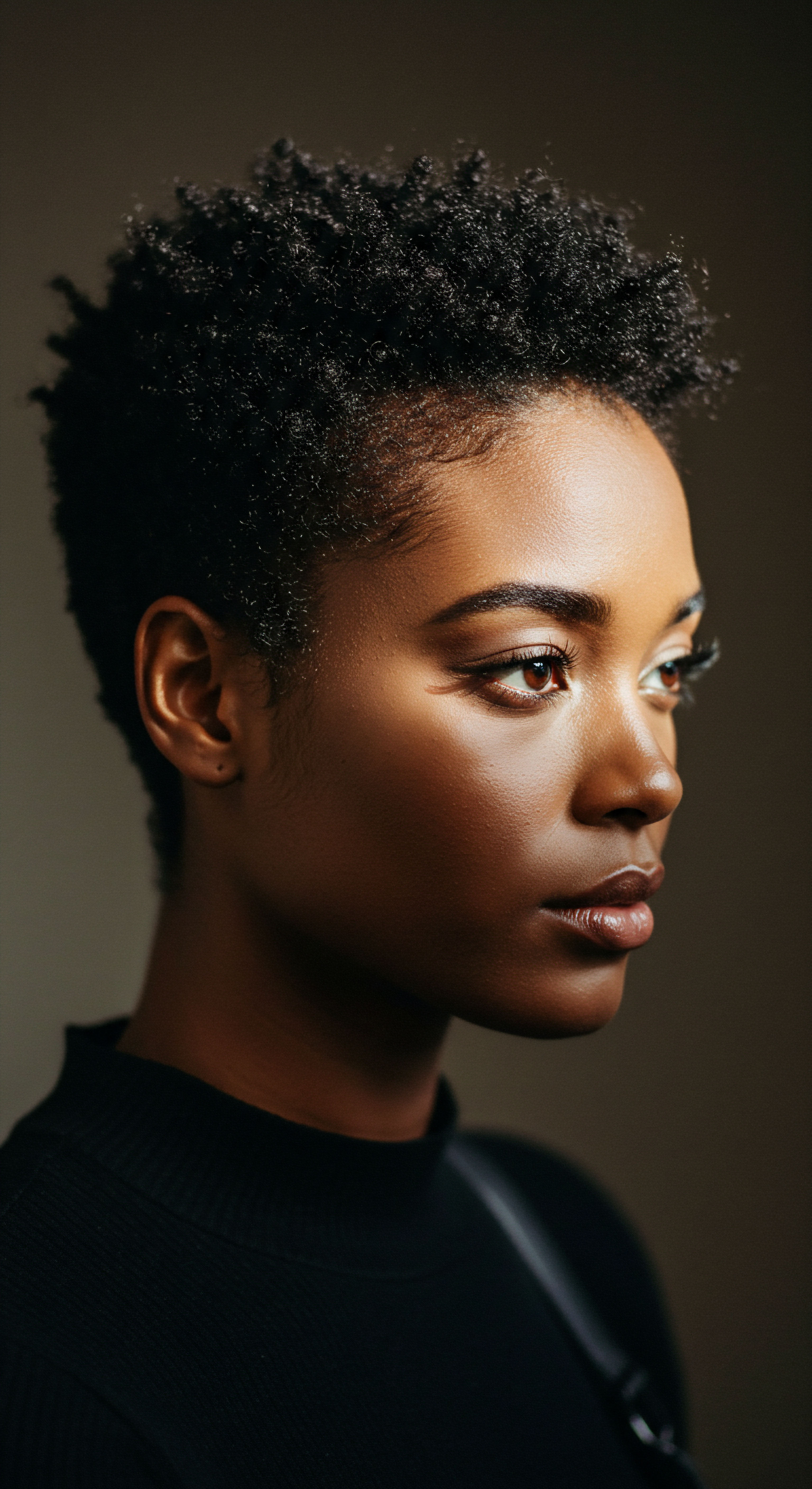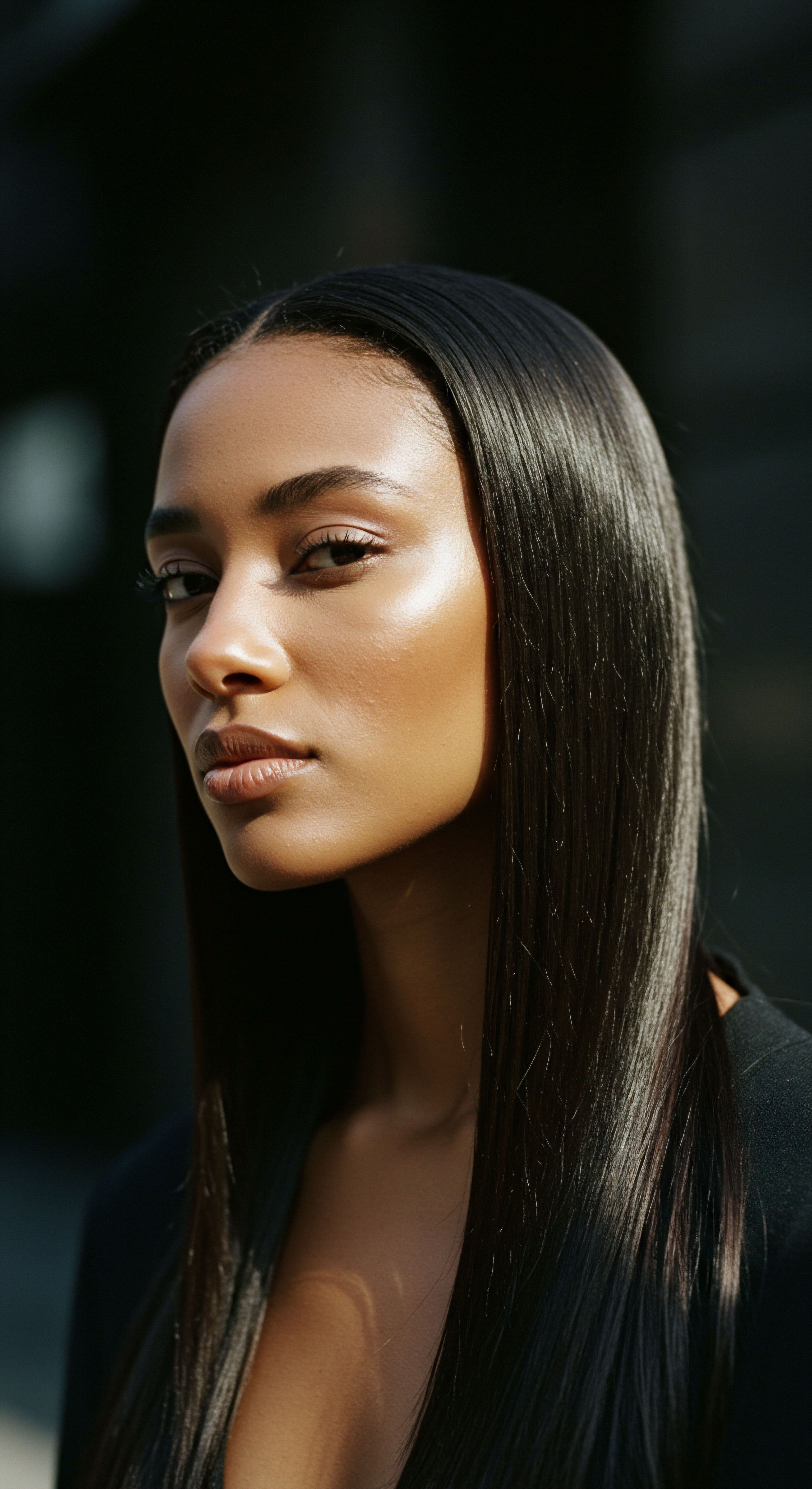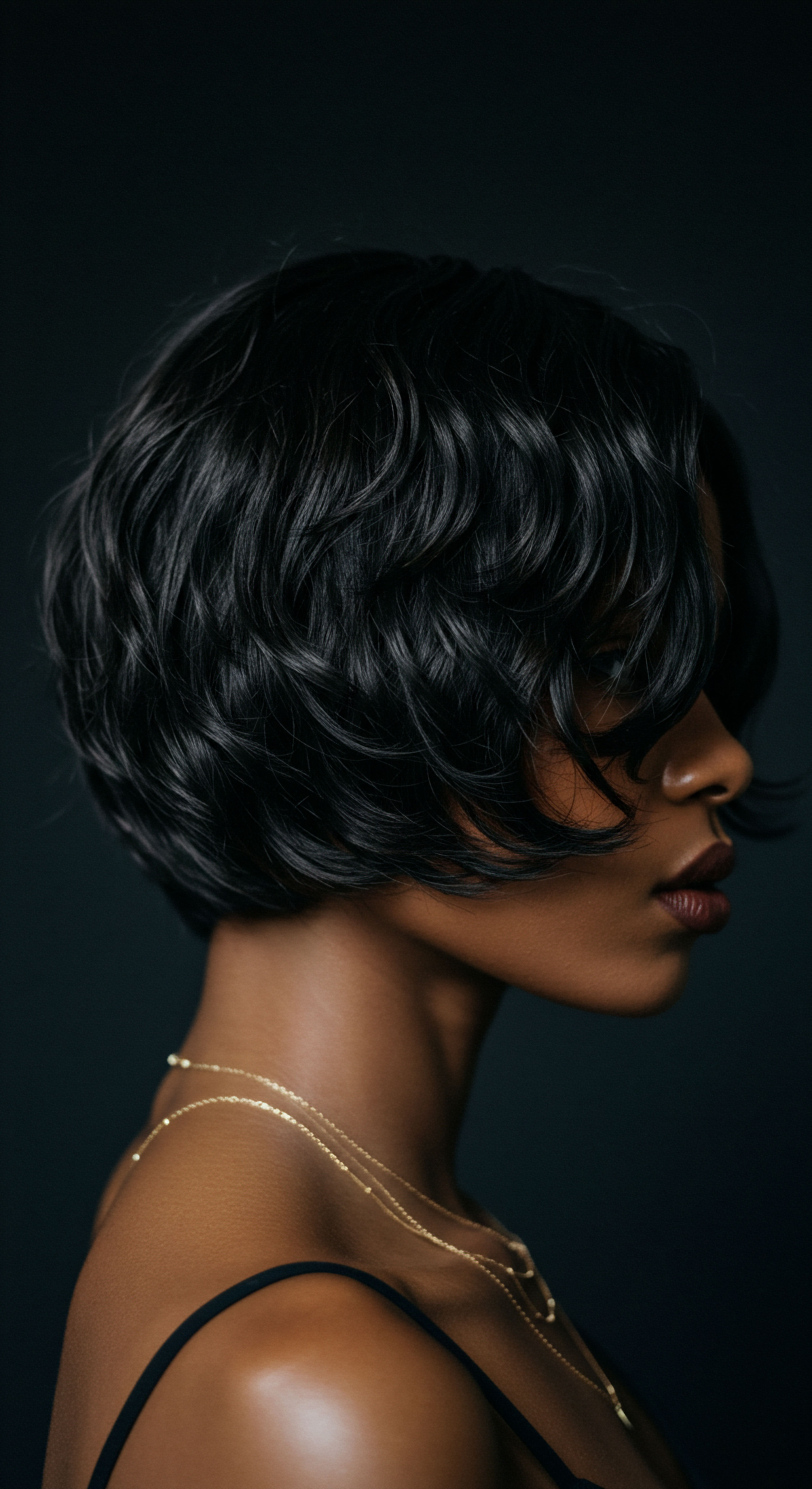
Roots
The journey into understanding coiled strands begins not with products or quick fixes, but with a quiet contemplation of their very nature, their intrinsic design, and the wisdom held within their unique architecture. Each curl, each coil, carries a story, a blueprint of resilience and a call for gentle care. To truly comprehend how historical practices shielded these magnificent strands from harm, one must first grasp the foundational truths of coiled hair itself. It is a dialogue between the hair and its environment, a delicate balance that has been understood and honored by ancestral hands for centuries.

The Architecture of Coiled Hair
Unlike straight or wavy hair, coiled strands possess a distinctive elliptical cross-section and a deeply curved follicle. This structural difference, observed under magnification, reveals why these hair types behave as they do. The twists and turns along the hair shaft create points where the cuticle, the hair’s protective outer layer, is more exposed and lifted. This inherent morphology means that natural oils produced by the scalp, known as sebum, struggle to travel down the length of the strand, leaving the ends particularly vulnerable to dryness.
Franbourg et al. (2003) noted that African hair exhibits many random twists and irregular direction changes, a characteristic contributing to its unique appearance and specific care requirements.
This structural reality underscores why coiled hair often feels drier than other hair types. The natural protective coating is less evenly distributed, leading to a predisposition for moisture loss and, subsequently, increased susceptibility to breakage. The delicate balance of moisture is a constant dance for coiled strands, and historical practices often revolved around supporting this delicate equilibrium.

Why is Coiled Hair Inherently Vulnerable?
The very beauty of coiled hair, its spring and volume, stems from its unique shape, yet this shape also presents specific challenges. The natural bends and turns along the hair shaft create areas of inherent weakness. When subjected to external forces, such as vigorous combing or tight styling, these points become stress concentrators, making the hair more prone to fracturing.
A large-population study highlighted that hair’s break stress diminishes with increased curliness, as defined by the Loussouarn scale, suggesting that the curls and twists in Afro-textured hair may create concentrations of stress and local points of weakness when stretched, leading to fracture formation. This mechanical fragility is a biological reality that historical practices instinctively addressed.
The unique architecture of coiled hair, with its elliptical cross-section and natural twists, renders it inherently prone to dryness and breakage.
The surface of coiled hair, with its lifted cuticle scales, can also create more friction between individual strands, leading to tangling and knotting. This tangling, if not managed with immense care, can further contribute to mechanical damage during detangling. Understanding these foundational aspects of coiled hair’s physical and mechanical properties forms the bedrock upon which effective, damage-preventing practices are built. It allows us to appreciate the ingenuity of ancestral methods that, without the aid of modern microscopes, seemed to intuit these vulnerabilities.
- Elliptical Cross-Section ❉ This shape, unlike the rounder cross-section of straight hair, creates natural bends and twists along the hair shaft.
- Lifted Cuticle Scales ❉ The curves of coiled hair can cause the protective outer cuticle layer to lift, making the hair more porous and susceptible to moisture loss and external damage.
- Uneven Sebum Distribution ❉ Due to the helical nature of the strand, the scalp’s natural oils struggle to travel down the entire length, leaving the ends particularly dry and vulnerable.

Ritual
Having reflected on the inherent qualities of coiled hair, we now turn our gaze to the deliberate, rhythmic practices that have long protected these strands. Historical hair care was not merely a routine; it was a ritual, a thoughtful sequence of actions imbued with a deep understanding of hair’s needs. These rituals, passed down through generations, reveal a profound practical wisdom, offering tangible lessons for preventing damage to coiled strands in any era. They speak to a mindful approach, where every touch, every application, served a specific, protective purpose.

The Gentle Art of Cleansing
Traditional cleansing methods for coiled hair often diverged significantly from the stripping shampoos prevalent in more recent times. Ancestral communities understood the delicate moisture balance of coiled strands and favored gentle, non-lathering alternatives. Instead of harsh detergents, substances like saponins from plants, various clays, or even simple water rinses were employed. These methods cleansed the scalp and hair without removing essential natural oils, preserving the hair’s integrity.
For instance, the concept of “co-washing,” or conditioner-only washing, a contemporary practice, mirrors the historical emphasis on gentle cleansing that prioritizes hydration over aggressive degreasing. This approach reduces the friction and dryness associated with harsh cleansers, which can lead to breakage.
Consider the preparation that often preceded cleansing. Many historical practices involved pre-treatment with oils or butters. This “pre-poo” concept, as it is known today, created a protective barrier on the hair shaft, reducing the amount of moisture stripped away during the wash process. This thoughtful layering of care exemplifies the preventative mindset embedded in these rituals.

How Did Ancestors Preserve Hair Moisture?
Moisture, the lifeblood of coiled hair, was guarded with diligence. Historical practices centered on both infusing and sealing in hydration. Natural emollients and humectants, readily available from the local environment, were regularly applied. Shea butter, cocoa butter, and various plant-based oils, such as coconut oil, olive oil, and jojoba oil, were staples.
These substances were not just applied; they were often warmed and massaged into the scalp and strands, promoting absorption and stimulating blood flow to the scalp, which supports overall hair health. This consistent application helped to counteract the natural tendency of coiled hair to dry out, keeping it pliable and less prone to snapping.
Historical hair care rituals prioritized gentle cleansing and consistent moisture replenishment, laying a foundation for strand resilience.
The application methods were often deliberate, ensuring thorough coverage without excessive manipulation. Finger-combing with oils, or using wide-toothed tools made from natural materials, helped to detangle gently, minimizing the mechanical stress that can lead to breakage.

Protective Styling as a Shield
Perhaps the most visually striking and enduring historical practice for preventing damage to coiled strands was the widespread adoption of protective styles. Braids, twists, cornrows, and various forms of hair wrapping were not merely aesthetic choices; they served as a literal shield for the hair. These styles minimized daily manipulation, reduced exposure to environmental elements like sun and wind, and kept delicate ends tucked away.
The longevity of these styles meant less frequent combing, brushing, and styling, directly reducing mechanical stress. A study evaluating hair care practices in African-American girls found that the risk of traction alopecia almost tripled with the use of cornrows if not properly managed, highlighting the importance of correct application and maintenance within protective styling. This underscores that while protective, these styles require a gentle hand and careful execution to truly confer their benefits.
| Practice Braiding and Twisting |
| Mechanism of Protection Reduces daily manipulation, minimizes exposure to elements, consolidates fragile strands. |
| Practice Hair Wrapping |
| Mechanism of Protection Shields hair from environmental factors, reduces friction against surfaces, preserves moisture. |
| Practice Low Manipulation Styling |
| Mechanism of Protection Decreases mechanical stress from combing, brushing, and heat styling, allowing hair to rest. |
The use of head coverings, such as wraps and bonnets, particularly during sleep, was another crucial element. These coverings, often made from smooth materials like silk or satin, reduced friction against rough surfaces like cotton pillowcases, which can cause snagging and breakage. This simple yet effective nighttime ritual protected the hair from tangling and preserved its moisture, ensuring the efforts of the day’s care were not undone during rest.

Relay
Our journey into historical hair practices now carries us to a deeper understanding, one where scientific insight meets ancestral wisdom. The principles that underpinned ancient methods for preventing damage to coiled strands were not accidental; they were often an intuitive response to the hair’s biological realities, a sophisticated dialogue between human observation and the natural world. This section will connect those time-honored techniques with modern scientific understanding, revealing a continuous thread of knowledge that stretches across generations and disciplines. We consider the interplay of biological, social, and cultural factors that shape hair health.

What is the Science Behind Low Manipulation?
The concept of minimal manipulation, a cornerstone of historical hair care, finds strong validation in contemporary hair science. Coiled hair, with its unique helical structure and elliptical cross-section, possesses inherent points of weakness. Studies on the mechanical properties of different hair types confirm that highly coiled hair has a lower tensile strength and is more susceptible to breakage when subjected to stretching, bending, and torsion. Franbourg et al.
(2003) showed that the irregular shape of African hair contributes to its fragility. Each time coiled hair is combed, brushed, or aggressively styled, it experiences micro-fractures, cumulative damage that ultimately leads to visible breakage and reduced length retention.
By embracing styles that require infrequent handling, such as braids, twists, or locs, historical communities effectively reduced the mechanical stress on the hair shaft. This practice minimizes the physical forces that cause breakage, allowing the hair to retain its length and strength. The simple act of leaving hair undisturbed for extended periods, as seen in many protective styles, directly translates into fewer opportunities for damage. This understanding, though perhaps not articulated in scientific terms by our ancestors, was certainly observed in the healthier, longer hair that resulted from such practices.

How Do Natural Oils and Butters Fortify Coiled Strands?
The widespread historical use of natural oils and plant-based butters for conditioning coiled hair is supported by modern research into lipid chemistry and hair physiology. Coiled hair, as noted, tends to be drier due to the difficulty of sebum traveling down its curves. Oils like coconut oil, olive oil, and shea butter are rich in fatty acids and have the ability to penetrate the hair shaft, or to form a protective layer on the cuticle.
Coconut oil, for example, with its low molecular weight and linear structure, can penetrate the hair shaft, reducing protein loss during washing. This protective action helps to maintain the hair’s internal structure, making it more resilient against external stressors.
The enduring strength of coiled hair is often attributed to the historical reliance on low manipulation practices and nutrient-rich natural emollients.
Beyond penetration, many traditional oils act as sealants, coating the hair shaft to reduce moisture evaporation. This external barrier helps to keep the hair hydrated and pliable, diminishing its tendency to become brittle and snap. The consistent application of these emollients, often through scalp massages, also improved scalp health, creating a better environment for hair growth.

The Cultural Context of Hair Health
The historical practices preventing damage to coiled strands were deeply intertwined with cultural identity and societal roles. Hair was not merely an adornment; it was a powerful symbol of status, spirituality, and group affiliation. As Sybille Rosado (2003) highlights, hair communicates one’s group identity and is perhaps more important than other characteristics such as skin color, language, or religion in the African diaspora. The deliberate and often time-consuming care rituals were acts of self-preservation and cultural continuity, particularly in the face of adversity.
Consider the CROWN 2023 Research Study, which found that 41% of Black women altered their hair from curly to straight for job interviews, and 54% believed they should have straight hair for such occasions. This contemporary data point, while reflecting modern pressures, starkly contrasts with historical periods where natural, coiled styles were the norm and often celebrated. The shift away from traditional, protective practices towards styles requiring chemical alteration or excessive heat, driven by external beauty standards, has been linked to increased hair damage and scalp conditions like Central Centrifugal Cicatricial Alopecia (CCCA).
A review of literature indicates that natural styles generally have the fewest adverse associations compared to other styles, and that chemical relaxers can significantly reduce the tensile strength of hair. This highlights a powerful, if sometimes uncomfortable, truth ❉ societal pressures can inadvertently lead to practices that compromise hair health, moving away from the preventative wisdom of historical methods.
The table below outlines how specific traditional practices align with scientific principles to promote hair integrity.
| Historical Practice Protective Styling (Braids, Twists) |
| Scientific Principle Addressed Reduces mechanical stress and friction on hair shaft. |
| Outcome for Coiled Hair Decreased breakage, increased length retention. |
| Historical Practice Natural Cleansing (Clays, Plant Saponins) |
| Scientific Principle Addressed Preserves natural sebum, maintains cuticle integrity. |
| Outcome for Coiled Hair Reduced dryness, less protein loss. |
| Historical Practice Oil Application (Shea, Coconut, Jojoba) |
| Scientific Principle Addressed Provides internal lubrication, seals cuticle, reduces moisture evaporation. |
| Outcome for Coiled Hair Enhanced elasticity, improved shine, less brittleness. |
| Historical Practice Nighttime Wrapping (Satin/Silk) |
| Scientific Principle Addressed Minimizes friction, prevents tangling and mechanical damage during sleep. |
| Outcome for Coiled Hair Reduced breakage, preserved style longevity. |
The deliberate choice of materials for tools also played a role. Wide-toothed combs crafted from wood or bone, or simply finger-detangling, minimized the snagging and pulling that modern fine-toothed plastic combs can cause on coiled strands. These tools, coupled with ample lubrication from oils, made the detangling process a gentle affair, reducing breakage. The confluence of cultural reverence, practical ingenuity, and an intuitive understanding of hair’s biology allowed historical hair practices to offer a profound model for preventing damage to coiled strands, a model that continues to resonate with scientific backing today.
- Reduced Tension ❉ Braids and twists, when installed without excessive tightness, minimize pulling on the scalp and hair follicles, which helps prevent traction alopecia.
- Environmental Shield ❉ These styles protect hair from harsh elements like sun, wind, and extreme temperatures, which can cause dryness and structural damage.
- Length Retention ❉ By minimizing daily manipulation and environmental exposure, protective styles allow coiled hair, which has a slower apparent growth rate due to shrinkage, to retain more of its length.

Reflection
As we conclude this exploration of historical hair practices and their enduring wisdom for coiled strands, a quiet truth settles ❉ the past offers not just echoes, but guiding whispers for our present. The ancestral reverence for hair, expressed through deliberate, gentle care, stands as a testament to deep understanding. These practices, rooted in observation and an intimate connection with nature, provide a timeless blueprint for fostering health and vitality in coiled hair.
They remind us that true care extends beyond fleeting trends, embracing a holistic approach that honors the hair’s inherent design and cultural significance. In these traditions, we find not only methods for preventing damage but also a profound invitation to reconnect with the serene beauty of our natural selves.

References
- Byrd, A. D. & Tharps, L. L. (2014). Hair Story ❉ Untangling the Roots of Black Hair in America. St. Martin’s Press.
- Franbourg, A. Hallegot, P. Baltenneck, F. Toutain, C. & Leroy, F. (2003). Current research on ethnic hair. Journal of the American Academy of Dermatology, 48(6 Suppl), S115-S119.
- Greene, A. (2012). African American women and the politics of hair. Journal of Black Studies, 43(4), 405-422.
- Khumalo, N. P. Jessop, S. Gumedze, F. & Ehrlich, R. (2007). Hairdressing and the prevalence of scalp disease in African adults. British Journal of Dermatology, 157(5), 981-988.
- Khumalo, N. P. & Ngwanya, R. M. (2007). Traction alopecia ❉ 2% topical minoxidil shows promise. Report of two cases. Journal of the European Academy of Dermatology and Venereology, 21(3), 433-434.
- Loussouarn, G. de La Mettrie, R. & Saint-Léger, D. (2007). Worldwide diversity of hair curliness ❉ A new method of assessment. International Journal of Dermatology, 46(Suppl 1), 2-6.
- Rosado, S. (2003). The Grammar of Hair ❉ Black Women’s Hair and the Diasporic Aesthetic. In D. J. Banks (Ed.), Hair Matters ❉ Beauty, Power, and the Politics of Hair in African American Culture (pp. 61-78). New York University Press.
- Rucker Wright, K. Gathers, D. C. & Kapur, S. (2011). Hair care practices and scalp disorders in African-American girls. Pediatric Dermatology, 28(6), 660-664.
- Samrao, A. Price, V. H. & Zedek, D. (2011). The “Fringe Sign” – A useful clinical finding in traction alopecia of the marginal hair line. Dermatology Online Journal, 17(1), 1.
- Sieber, R. & Herreman, F. (2000). Hair in African Art and Culture. Museum for African Art.
- Wong, N. Williams, K. Tolliver, S. & Potts, G. (2025). Historical Perspectives on Hair Care and Common Styling Practices in Black Women. Cutis, 115(3), 95-99, E6-E8.